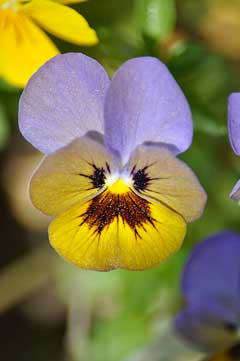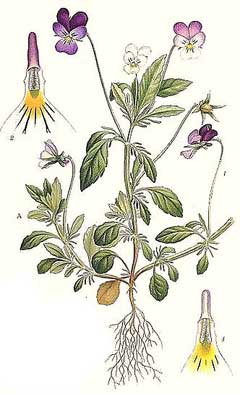 |
|
commons.wikimedia.org/wiki/User:Vonvikken |
 |
| commons.wikimedia.org/wiki/File:227_Viola_tricolor,_Viola_arvensis.jpg |
Translate this page:
Summary
Bloom Color: Purple, White, Yellow. Main Bloom Time: Early summer, Early fall, Late summer, Late spring, Mid summer, Mid fall, Mid spring. Form: Spreading or horizontal.
Physical Characteristics

 Viola tricolor is a ANNUAL/PERENNIAL growing to 0.2 m (0ft 8in) by 0.2 m (0ft 8in) at a medium rate.
Viola tricolor is a ANNUAL/PERENNIAL growing to 0.2 m (0ft 8in) by 0.2 m (0ft 8in) at a medium rate.
See above for USDA hardiness. It is hardy to UK zone 4 and is not frost tender. It is in flower from April to September, and the seeds ripen from June to September. The species is hermaphrodite (has both male and female organs) and is pollinated by Bees. The plant is self-fertile.
It is noted for attracting wildlife.
Suitable for: light (sandy), medium (loamy) and heavy (clay) soils and prefers well-drained soil. Suitable pH: mildly acid and neutral soils. It can grow in semi-shade (light woodland) or no shade. It prefers moist soil.
UK Hardiness Map
US Hardiness Map
Synonyms
Plant Habitats
Lawn; Meadow; Cultivated Beds;
Edible Uses
Edible Parts: Flowers Leaves
Edible Uses: Tea
Young leaves and flower buds - raw or cooked[105]. When added to soup they thicken it in much the same way as okra[85, 159]. A tea can be made from the leaves[85]. The small attractive flowers are added to salads or used as a garnish[183].
References More on Edible Uses
Medicinal Uses
Plants For A Future can not take any responsibility for any adverse effects from the use of plants. Always seek advice from a professional before using a plant medicinally.
Anodyne Antiasthmatic Antiinflammatory Antiseborrheic Antispasmodic Cardiac Demulcent Depurative
Diaphoretic Diuretic Eczema Emetic Emollient Epilepsy Expectorant
Homeopathy Laxative Vulnerary
Heartsease has a long history of herbal use and was at one time in high repute as a treatment for epilepsy, asthma, skin diseases and a wide range of other complaints[4]. In modern herbalism it is seen as a purifying herb and is taken internally in the treatment of skin complaints such as eczema[254]. The herb is anodyne, antiasthmatic, anti-inflammatory, cardiac, demulcent, depurative, diaphoretic, diuretic, emollient, expectorant, laxative and vulnerary[4, 7, 9, 13, 21, 46, 165]. Being expectorant, it is used in the treatment of various chest complaints such as bronchitis and whooping cough, whilst its diuretic action makes it useful for treating rheumatism, cystitis and difficulty in passing urine[254]. It is also used as an ointment for treating eczema and other skin complaints and is also useful in cases of rheumatism, bed-wetting etc[4, 9]. The plant is harvested from June to August and dried for later use[4]. The root is emetic[7]. A homeopathic remedy is made from the entire plant[4]. It is used in the treatment of cutaneous eruptions[4].
References More on Medicinal Uses
The Bookshop: Edible Plant Books
Our Latest books on Perennial Plants For Food Forests and Permaculture Gardens in paperback or digital formats.

Edible Tropical Plants
Food Forest Plants for Hotter Conditions: 250+ Plants For Tropical Food Forests & Permaculture Gardens.
More

Edible Temperate Plants
Plants for Your Food Forest: 500 Plants for Temperate Food Forests & Permaculture Gardens.
More

More Books
PFAF have eight books available in paperback and digital formats. Browse the shop for more information.
Shop Now
Other Uses
Dye Litmus
Yellow, green and blue-green dyes are obtained from the flowers[168]. The leaves can be used in place of litmus in testing for acids and alkalis[4].
Special Uses
Attracts Wildlife
References More on Other Uses
Cultivation details
Landscape Uses:Alpine garden, Border, Container, Massing, Rock garden. Prefers a cool moist well-drained humus-rich soil in partial or dappled shade and protection from scorching winds[31, 53]. Tolerates sandstone and limestone soils but becomes chlorotic if the pH is too high[200]. Prefers a pH between 6 and 6.5[200]. A very variable species[4]. It is normally an annual plant, but it is sometimes a short-lived perennial[187]. A good bee plant[24]. Grows well with rye but dislikes growing with wheat[18]. All members of this genus have more or less edible leaves and flower buds, though those species with yellow flowers can cause diarrhoea if eaten in large quantities[62, 85, 159]. Special Features:Not North American native, Naturalizing, Suitable for cut flowers, Extended bloom season in Zones 9A and above, Fragrant flowers.
References Carbon Farming Information and Carbon Sequestration Information
Temperature Converter
Type a value in the Celsius field to convert the value to Fahrenheit:
Fahrenheit:
The PFAF Bookshop
Plants For A Future have a number of books available in paperback and digital form. Book titles include Edible Plants, Edible Perennials, Edible Trees,Edible Shrubs, Woodland Gardening, and Temperate Food Forest Plants. Our new book is Food Forest Plants For Hotter Conditions (Tropical and Sub-Tropical).
Shop Now
Plant Propagation
Seed - best sown in the autumn in a cold frame. Division in the autumn or just after flowering. The plant is a short-lived perennial and division is not that worthwhile.
Other Names
If available other names are mentioned here
Native Plant Search
Search over 900 plants ideal for food forests and permaculture gardens. Filter to search native plants to your area. The plants selected are the plants in our book 'Plants For Your Food Forest: 500 Plants for Temperate Food Forests and Permaculture Gardens, as well as plants chosen for our forthcoming related books for Tropical/Hot Wet Climates and Mediterranean/Hot Dry Climates. Native Plant Search
Found In
Countries where the plant has been found are listed here if the information is available
Weed Potential
Right plant wrong place. We are currently updating this section.
Please note that a plant may be invasive in one area but may not in your area so it’s worth checking.
Conservation Status
IUCN Red List of Threatened Plants Status :

| Related Plants
|
| Latin Name | Common Name | Habit | Height | Hardiness | Growth | Soil | Shade | Moisture | Edible | Medicinal | Other |
| Aconitum violaceum | | Perennial | 0.0 |
5-9
| | LMH | SN | M | 1 | 1 | |
| Cardamine violacea | | Perennial | 0.3 |
-
| | LMH | SN | M | 2 | 0 | |
| Gigantochloa atroviolacea | Black Bamboo. Giant Black bamboo | Bamboo | 12.0 |
9-11
| M | LMH | SN | M | 2 | 0 | 3 |
| Hardenbergia violacea | Coral Pea, Purple Coral Pea, False Sarsaparilla, Vine Lilac | Climber | 2.0 |
9-11
| F | LMH | SN | M | 1 | 0 | 1 |
| Hymenanthera dentata | Tree Violet | Shrub | 6.0 |
8-11
| | LMH | N | M | 0 | 0 | 2 |
| Melicytus ramiflorus | Whitey Wood | Tree | 9.0 |
8-11
| | LMH | N | M | 1 | 0 | 2 |
| Orychophragmus violaceus | | Annual/Biennial | 0.3 |
6-9
| | LMH | N | M | 1 | 0 | |
| Oxalis violacea | Violet Wood Sorrel | Bulb | 0.3 |
4-8
| | LMH | SN | DM | 3 | 1 | |
| Tulbaghia violacea | Society Garlic | Perennial | 0.3 |
7-11
| F | LMH | N | M | 4 | 2 | 3 |
| Viola acuminata | | Perennial | 0.3 |
-
| | LMH | SN | M | 2 | 0 | |
| Viola adunca | Western Dog Violet, Hookedspur violet, Kirk's violet | Perennial | 0.1 |
4-8
| | LMH | SN | M | 3 | 1 | 2 |
| Viola biflora | Twoflower Violet, Arctic yellow violet, Carlott's violet | Perennial | 0.2 |
0-0
| | LMH | S | M | 3 | 1 | 1 |
| Viola brevistipulata | | Perennial | 0.3 |
-
| | LMH | SN | M | 2 | 0 | |
| Viola canadensis | Canada Violet, Canadian white violet, Creepingroot violet | Perennial | 0.4 |
3-8
| | LMH | SN | M | 3 | 1 | 2 |
| Viola canina | Dog Violet | Perennial | 0.4 |
5-9
| | LMH | SN | M | 3 | 1 | |
| Viola collina | | Perennial | 0.1 |
-
| | LMH | SN | M | 2 | 0 | |
| Viola cornuta | Horned Violet, Bedding Pansy, Tufted Pansy, | Perennial | 0.2 |
6-11
| F | LMH | SN | M | 3 | 0 | 3 |
| Viola cucullata | Marsh Blue Violet | Perennial | 0.2 |
3-8
| | LMH | SN | MWe | 3 | 1 | 3 |
| Viola diffusa | | Annual | 0.1 |
-
| | LMH | SN | M | 2 | 2 | |
| Viola epipsila | Dwarf Marsh Violet | Perennial | 0.1 |
4-8
| | LMH | SN | M | 3 | 0 | 1 |
| Viola esculenta | Salad violet | | 0.0 |
0-0
| | LMH | SN | M | 0 | 0 | |
| Viola glabella | Stream Violet, Pioneer violet | Perennial | 0.1 |
4-8
| | LMH | S | M | 2 | 0 | |
| Viola grypoceras | | Perennial | 0.3 |
-
| | LMH | SN | M | 2 | 0 | |
| Viola japonica | Japanese violet | Perennial | 0.2 |
0-0
| | LMH | SN | M | 3 | 2 | |
| Viola keiskei | | Perennial | 0.2 |
-
| | LMH | SN | M | 2 | 0 | |
| Viola labradorica | Labrador Violet, Alpine violet, Johnny Jump-Up, Alpine Violet | Perennial | 0.1 |
3-8
| F | LMH | FSN | M | 3 | 0 | 2 |
| Viola langsdorffii | Alaska Violet. Aleutian violet | Perennial | 0.1 |
-
| | LMH | SN | M | 3 | 0 | |
| Viola mandshurica | Manchurian Violet | Perennial | 0.2 |
7-10
| | LMH | SN | M | 3 | 0 | |
| Viola mirabilis | wonder violet | Perennial | 0.2 |
4-8
| | LMH | SN | M | 3 | 1 | |
| Viola obtusa | | Perennial | 0.1 |
-
| | LMH | SN | M | 2 | 0 | |
|
|
Growth: S = slow M = medium F = fast. Soil: L = light (sandy) M = medium H = heavy (clay). pH: A = acid N = neutral B = basic (alkaline). Shade: F = full shade S = semi-shade N = no shade. Moisture: D = dry M = Moist We = wet Wa = water.

Expert comment
Author
L.
Botanical References
17200
Links / References
For a list of references used on this page please go here
Readers comment